As a gardening enthusiast, I often explore different materials that could enrich my compost bin, and pine needles have piqued my interest. Dive into the world of composting and you’ll quickly discover that pine needles, the abundant byproduct of pine trees, are indeed compostable.
However, their presence in a compost pile sparks debate due to their specific properties (their waxy coating and inherent acidity) that could potentially influence the breakdown process and the final ph level of compost.
When handled correctly, incorporating pine needles can add value to your compost heap, contributing to the carbon balance crucial for successful decomposition.
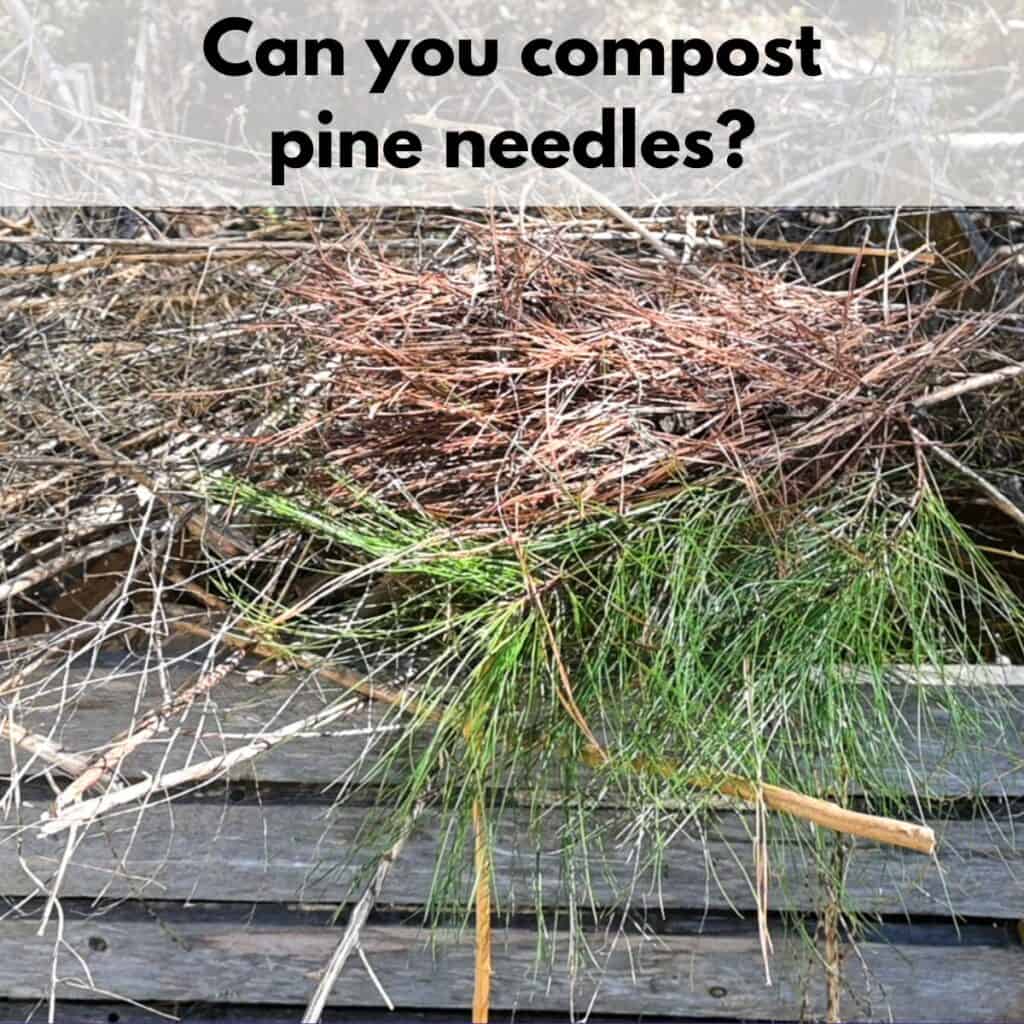
Considering pine needles for your compost requires an intentional approach. It’s important to gauge the proportion of these needles to prevent overpowering the mix with their acidic nature and slower decomposition rate. Understanding that pine needles break down at a slower rate compared to other organic materials is vital for setting realistic expectations for your compost pile’s maturation.
Key Takeaways:
- Pine needles can be composted, contributing to the carbon balance needed for decomposition.
- Pine needles decompose slowly and must be proportioned correctly to avoid excessive acidity in the compost.
- Proper practices ensure that pine needle compost is an asset, not a detriment, to your garden’s health.
This post includes affiliate links. If you make a purchase using one of these links, Together Time Family will receive a commission at no additional cost to you.
Table of Contents
Understanding Pine Needles as Compost Material
Pine needles, the slender leaves shed by pine trees, possess characteristics that influence their role in composting.
Each needle is encapsulated in a protective waxy coating. This results in a more extended breakdown time compared to many other organic materials. This persistence is an aspect to consider as you build compost mix that maintains an equilibrium between decomposition rates.
The acidity they contain initially might cause concerns about altering the pH of the soil, but this acidity diminishes significantly as they decompose. This means pine needles ultimately won’t overly affect your soil ph too much.
During composting, equilibrium between ‘green’ and ‘brown’ materials is important.
- The green materials, including vegetable scraps and grass clippings, are rich in nitrogen, providing the compost with critical proteins.
- The brown materials, where pine needles fall, are carbon sources that give the compost its structure and energy.
For optimal results, try to achieve a balanced ratio of greens to browns. Pine needles, as a brown component, offer a good carbon source. Their inclusion supports creating a diverse and well-rounded compost that serves as a bedrock for flourishing garden plants, enhancing the nutrient cycle and soil structure. I don’t stress too much about the exact mix, though.
Both fresh green and dry pine needles/pine straw can be used. Find a little pine sapling like the one below? Cut it off and toss it in the compost.
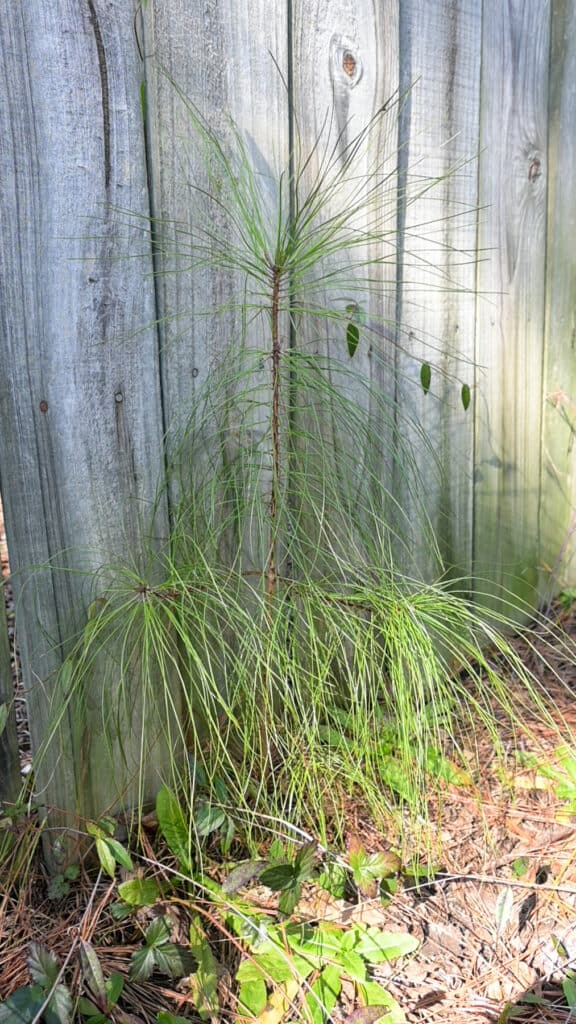
Benefits of Composting Pine Needles
- Rich Carbon Source: Pine needles serve as ‘brown materials’ offering an abundant carbon supply. This balances the nitrogen in ‘green materials’ like vegetable scraps.
- Slow Decomposition: Their slow breakdown pace allows for extended nutrient release and maintains compost structure over time.
- Improved Aeration: The physical structure of pine needles promotes airflow within the compost pile, reducing compaction and encouraging aerobic decomposition.
- Mulching Potential: Once broken down, pine needle compost works excellently as mulch, offering soil insulation and moisture retention.
- Acidic Adjustment: Ideal for acid-loving plants, pine needle compost gradually adjusts soil acidity levels without a sudden pH shift.
- Pest Deterrence: The natural compounds in pine needles can deter certain garden pests, enhancing plant protection when used as compost or mulch.
- Resource Utilization: Composting pine needles is an eco-friendly way to repurpose what might otherwise be yard waste, minimizing environmental impact.
- Biodiversity Boost: A diverse array of microorganisms thrives on the complex components of pine needles, enriching the compost’s biological profile.
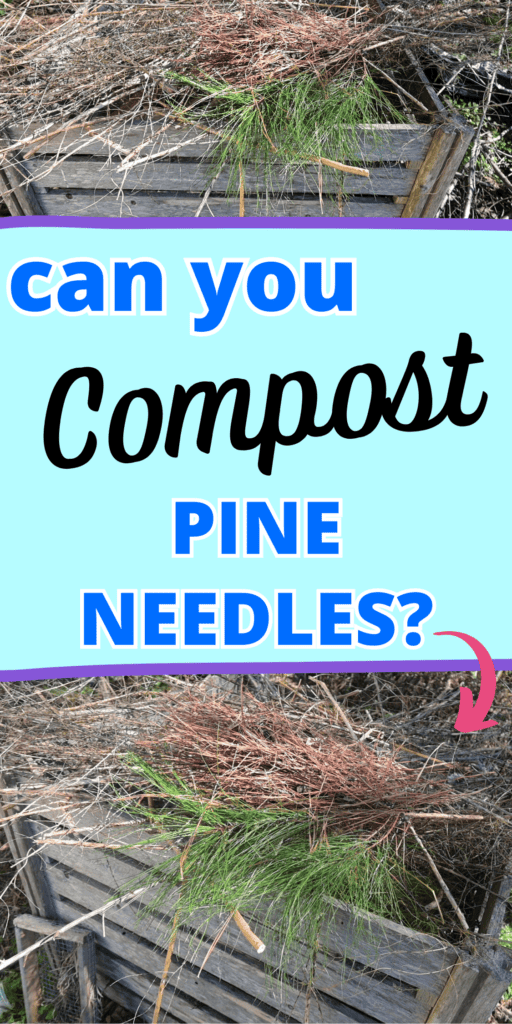
Best Practices for Composting Pine Needles
Composting pine needles requires a bit of know-how to get the balance right in your compost bin.
First off, think of these needles as a source of carbon, balancing them with nitrogen-rich ‘green’ kitchen scraps and lawn clippings. As for quantity, pine needles should make up no more than 10% of your compost heap to avoid excessive acidity and slow decomposition. Putting a lot of pine needles in your compost bin can slow down the composting process.
Here’s a pro tip: chop or shred the needles before adding them to the compost. This reduces their size, making them easier for the microbes to break down. You can run a lawn mower over them or use a shredder. With smaller pieces, you accelerate the decomposition process significantly.
Here’s a look at why you need to mulch your pine straw and mix it with other materials in your compost. This Christmas tree has been sitting outside for a year:
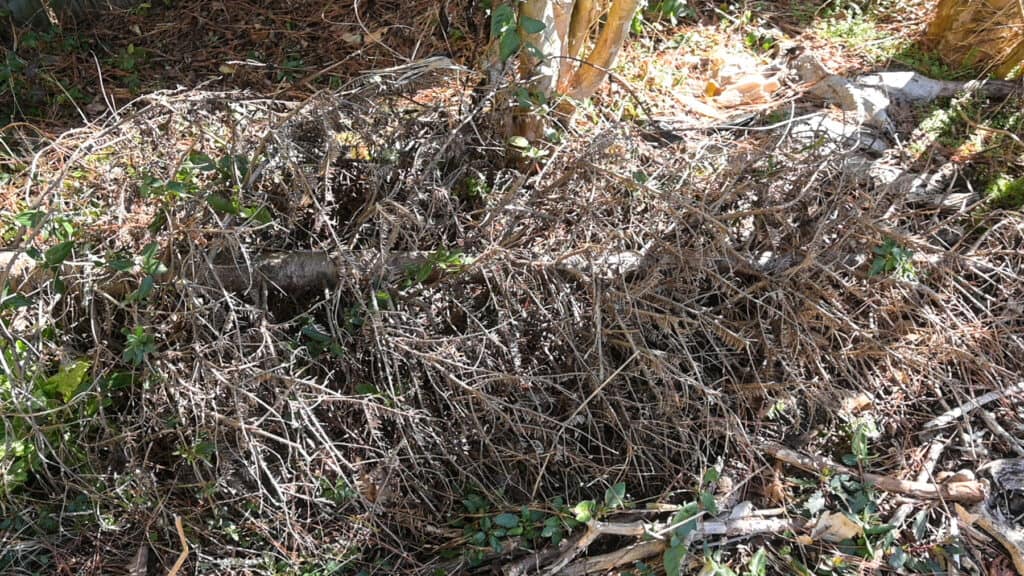
And this pine straw was used as mulch a year ago. It was placed on the ground in a thick layer and not watered or stirred.
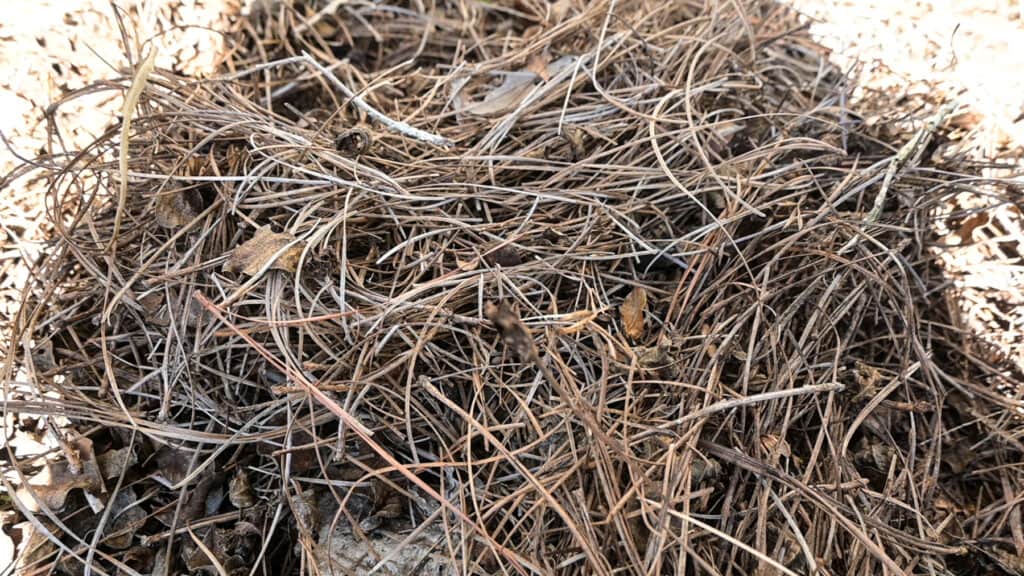
Doesn’t look much like compost, does it?
Let’s talk about the composting environment. Moisture and warmth are instrumental in turning organic waste into rich compost. Keep your compost moist, like a wrung-out sponge, and turn it regularly with a garden fork to introduce oxygen and distribute the heat evenly. In colder climates, a hot composting method might be a good fit – it’s quick, maintains high temperatures, and ensures a faster breakdown of tough pine needles.
Remember, consistency in managing your compost heap will yield the best results.
Common Concerns and Solutions
Many gardeners worry about the acidity of pine needles and wonder whether they’ll adversely affect the pH of their compost and, ultimately, their soil.
It’s true that fresh pine needles have a low pH, but as they break down, they become more neutral. The initial acid content shouldn’t cause a lot of concern. If you’re still uneasy about this, mixing pine needles with other organic waste can dilute any effects of their innate acidity.
Also, remember that most garden plants prefer acidic soil. Favorites like tomatoes and blueberries thrive in acidic conditions.
Another issue that can come up is the sluggish decomposition rate of pine needles due to their waxy coating. You can chop them into smaller pieces to expedite the process. This can be done a lawn mower or a shredder. This increases the surface area for microbes to do their work and helps integrate the pine needles better with the rest of your compost materials.
Do not just throw a heap of pine needles on top of your mostly finished compost and expect good results. If you want to add needles to an existing pile, mix them in.
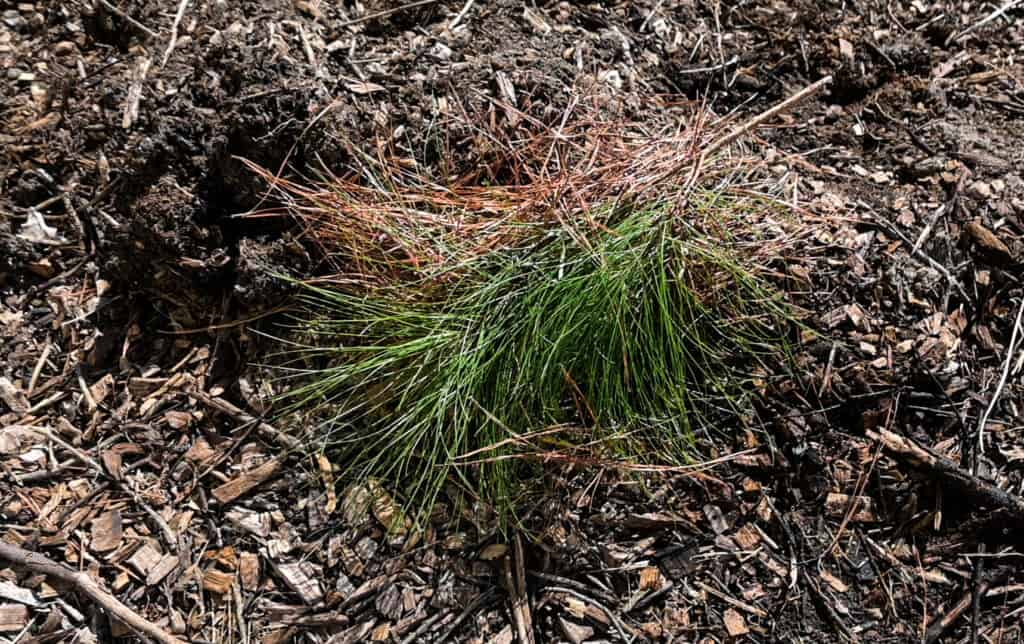
Some people are afraid that a pile of pine needles could lead to an imbalanced compost heap leaning towards a low pH. To combat this, ensure a good mix of green materials like vegetable scraps and grass clippings. These ‘greens’ complement the ‘browns’ that pine needles represent, fostering a thriving environment for the good bacteria necessary for nutrient-rich compost.
For those concerned with the pH level of their compost impacting their garden soil, conducting a simple pH test on your compost before using it can offer peace of mind. Remember, a well-managed compost heap, where browns and greens are adequately balanced, should create compost with a more neutral to lightly acidic pH, suitable for most garden plants.
How to maintain a well-managed compost pile
I had a lot of failed compost piles before I learned how to make good compost more quickly and effectively.
Many home compost piles suffer from two fatal flaws: they are too dry and don’t have enough matter.
For a compost pile that gets hot and decomposes quickly, you must have adequate brown feedstocks and greens added at the same time. Yes, you can add new materials and throw your kitchen scraps on top, but you need to put in the extra work of gathering adequate materials to get the pile started.
Ideally you’ll want about a cubic yard of material to start your pile. Less is okay, but you need enough to make a decent “heap.”
This is easier to do than you might think. Let your grass grow a bit longer than usual, then gather up all your clippings. Rake up some dry pine needles or pull out a bag of leaves from the fall. You can also ask neighbors for their leaves and grass clippings. Most people are more than happy to let you pick up their yard “waste.”
Do not dump everything into a big heap and call it a day. Your grass clippings will get weird and slimy while your pine needles don’t break down. You need to “lasagne” your compost. Alternate layering browns and greens. I also recommend layering in bonus materials, like a bit of kelp meal and EM-1 microbes, to boost the nutritional content of your compost and accelerate decomposition with beneficial microbes.
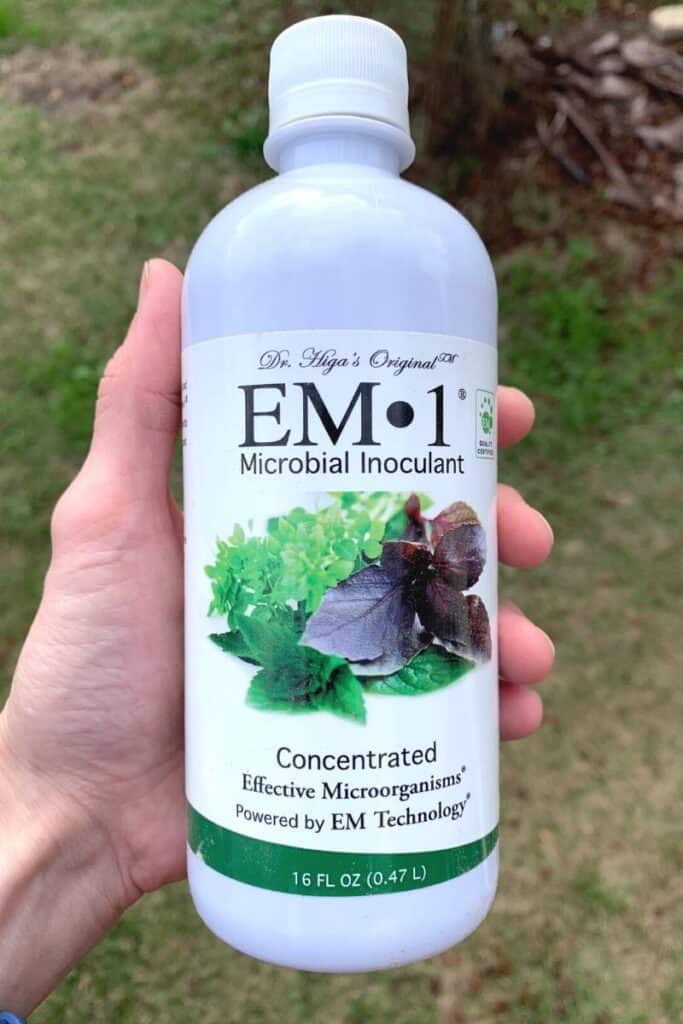
EM-1 is pricey to buy initially, but the company supplies instructions on how to make your own by using your purchased EM-1 as a starter culture.
Even though it’s physically brown, fresh manure counts as a “green” because of the high nitrogen content. It can be added to your pile, too, as long as you’re confident it isn’t contaminated with herbicides.
Once your pile is stacked up, water it. Water until the water flows out of the bottom of the pile. Then you may want to tarp your pile. This is optional, but helps retain heat and moisture.
The chemical reactions that need to take place use water, so you’ll nee to continue watering your pile regularly. Once a week is usually adequate. It’s a good idea to grab a garden fork and turn your pile once a week, then water it and tarp it again.
When you follow this method, you’ll have a balanced compost composition and compost that’s ready to use more quickly than if you make a mouldering pile that never really gets hot. Compost made with this method can be decomposed in as little as 4-6 weeks (though many soil experts recommend letting it age for a couple more months before applying it to your plants).
You’ll know your pile is working well when you see steam when you turn it! (I have a cool video of this somewhere, but I can’t locate it. I’ll updte the post if I can find the video clip.)
Creative Uses for Pine Needle Compost
My garden has always embraced the diversity of organic waste (I even compost meat and bones, but that’s a post for another day).
This nutrient-rich compost serves a special role, particularly for acid-loving plants like blueberries, azaleas, and tomatoes. These species thrive in the slightly acidic conditions that pine needle compost can help maintain. By integrating this compost into the soil, I ensure that these plants receive the acidic environment they crave without the need for chemical fertilizers.
If you decide not to compost them, pine needles make for great mulch around the base of plants. They offer a natural barrier against weed growth and help the soil retain moisture during dry spells. This is especially beneficial during hot summers or periods of heavy rain when the soil might otherwise erode. Pine needles interlock to form a sturdy but porous carpet that allows water and air to penetrate while keeping the soil structure intact.
We have pine needle mulch along our fence and in front of our house.
For a productive worm bin, I’ve learned that pine needles can provide carbon-rich bedding for the worms. They help balance the nitrogen-rich kitchen scraps, leading to a more efficient vermicomposting process. Not to mention, the resultant castings from worms feasting on this mixture are like gold for my vegetable garden and compost pile (I’ve added extra red wrigglers directly to my compost bin). My daughter calls them “wormie squirmies” and loves finding them in our compost pile.
- Adaptability: Pine needles adapt to various roles in the garden, from soil conditioner to pest repellent.
- Resourcefulness: They transform a waste product into something valuable, reducing the need for outside resources to maintain garden health.
- Conservation: Using pine needles as garden aids contributes to water conservation and soil integrity, matching my sustainable gardening ethos.
Wrapping Up with a Pine Needle Promise
I’ve taken you through the ins and outs of composting pine needles. I hope it’s clear to you that they deserve a green light in your composting endeavors.
Not only do they bring balance as a brown material rich in carbon, but they also play an integral part in creating a healthy compost ecosystem. Keep in mind the advice shared: moderate the quantity, shred for quicker decomposition, and monitor the balance to keep the compost thriving.
Pine needles, especially when prepped and managed correctly in the compost heap, promise to enrich your compost and garden. They might decompose at a slower pace, but patience here is rewarded with rich, nutritious compost perfect for many garden plants. Your evergreen’s byproducts need not go to waste; instead, they can be part of a sustainable cycle that enhances your soil’s vitality.
I encourage you to try including pine needles in your next compost batch. Remember, gardening is an adventure and composting with pine needles could be your next great discovery.
Give it a shot, monitor the results, and watch as your garden thanks you with vibrant growth and health. Embrace this natural, resourceful path to garden enrichment. It’s a simple step for greater sustainability in your gardening practice.
Compost Tips
Do you know how to tell when your compost is ready to use? And how long does compost take, anyway?
You know your compost needs to be turned, but you're tired of breaking your back. Discover the best compost aerators to make aerating your compost easy.
Discover how to attract more earthworms to your garden for healthy soil and bountiful yields.
Natasha Garcia-Lopez is an avoid home-gardener and proud owner of 88 acres of land in rural West Virginia. She was a member of the Association for Living History Farms and Agricultural Museums for many years and is currently enrolled in the Oregon State University Master Gardner Short Course program so she can better assist you with your gardening questions.She holds a certificate in natural skincare from the School of Natural Skincare.

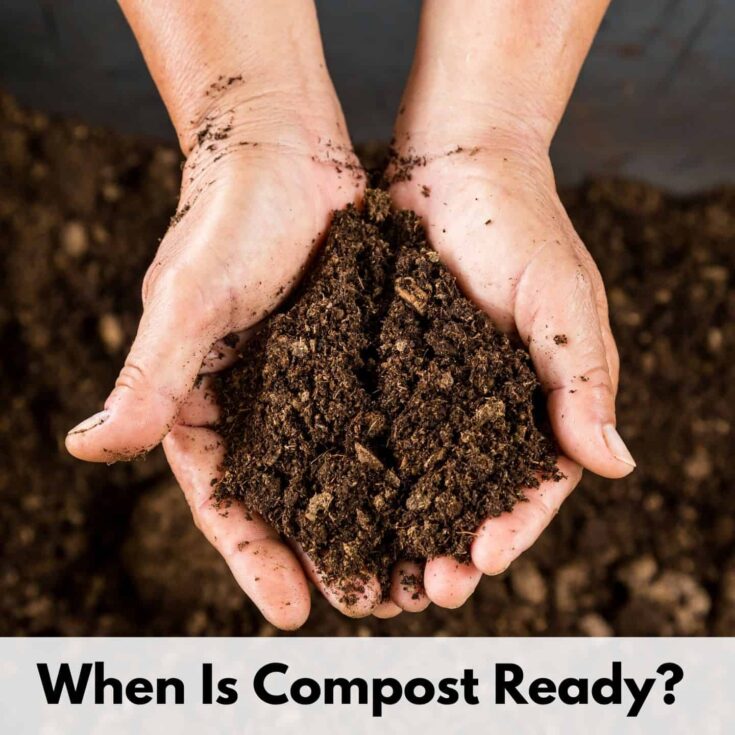
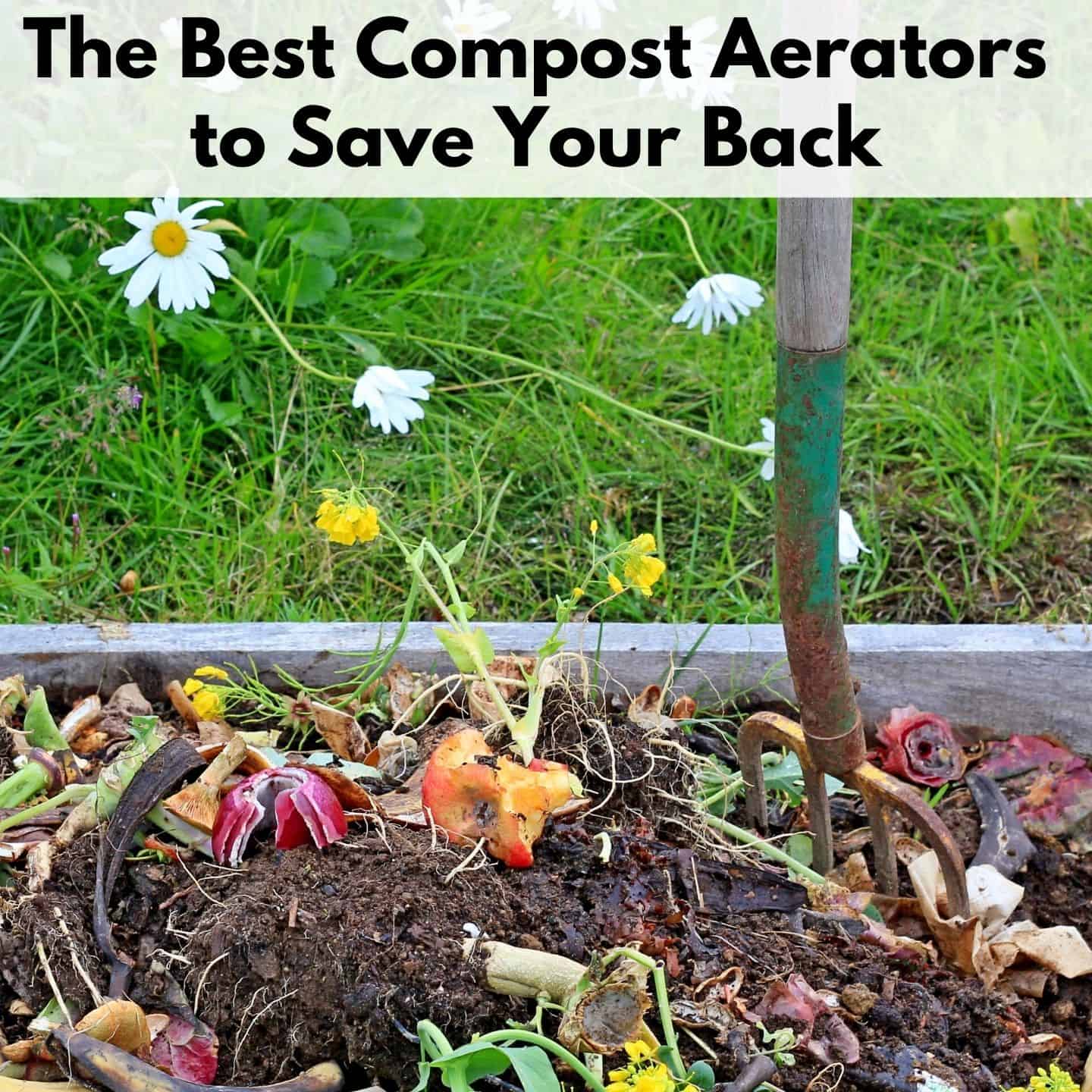


Leave a Reply